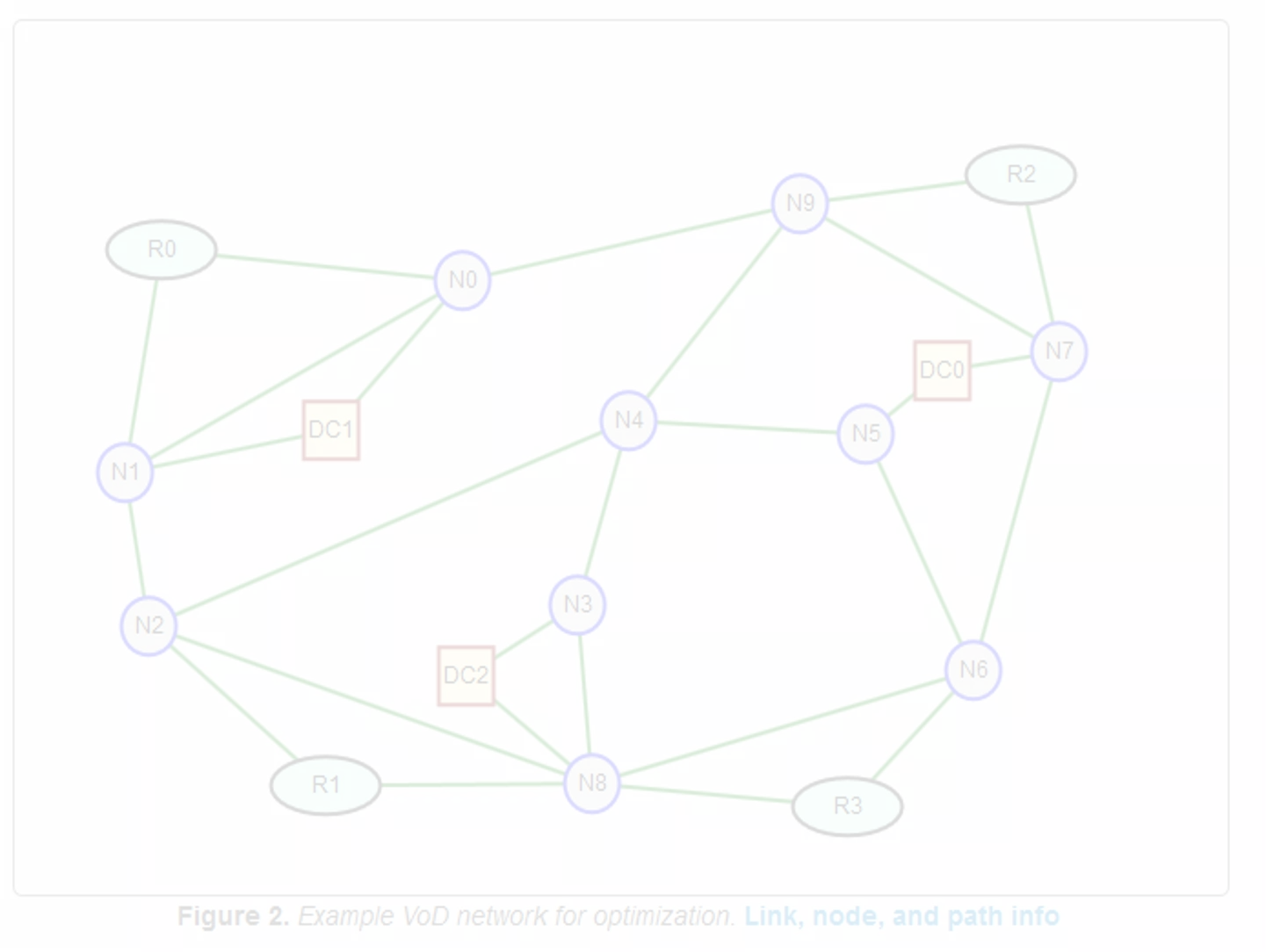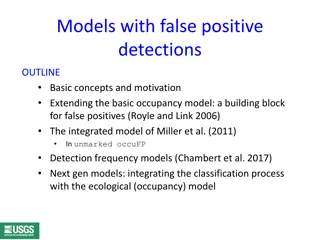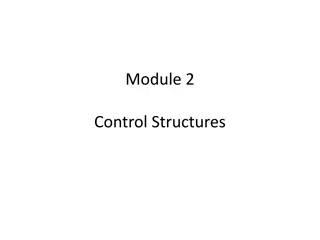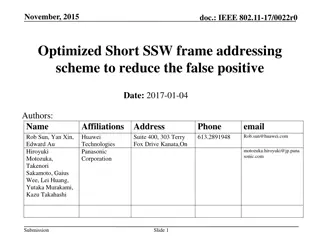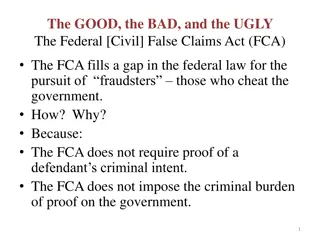False Path Analysis and Critical Path Analysis
False path analysis involves identifying certain timing paths in a design that are not functional and can be disabled to optimize analysis time. Meanwhile, critical path analysis in STA verifies design timing, focusing on critical paths that need attention. Learn about setting false paths, advantages, and disadvantages, as well as the importance of avoiding false paths in multi-cycle scenarios. Explore how STA aids in timing verification and logic optimization, highlighting the significance of identifying critical timing paths for optimal design performance.
Download Presentation

Please find below an Image/Link to download the presentation.
The content on the website is provided AS IS for your information and personal use only. It may not be sold, licensed, or shared on other websites without obtaining consent from the author.If you encounter any issues during the download, it is possible that the publisher has removed the file from their server.
You are allowed to download the files provided on this website for personal or commercial use, subject to the condition that they are used lawfully. All files are the property of their respective owners.
The content on the website is provided AS IS for your information and personal use only. It may not be sold, licensed, or shared on other websites without obtaining consent from the author.
E N D
Presentation Transcript
Shortest Path Algorithm Review and the k-shortest path Algorithm Dr. Greg Bernstein Grotto Networking www.grotto-networking.com
Shortest Path Techniques Approach Represent the network by a graph with weights or costs for links. Types of Link Weights link wt. = link miles => route miles shortest path link wt. = 1 => minimum hop count path link wt. = ln(pi) , where pi is the probability of failure on a link i, => lowest probability of failure path Link wt. = inverse of link bandwidth, crude traffic engineering
The Bellman-Ford Algorithm Choose the source node, s. We will find the shortest path from this node to all other nodes. Let w(j, v) be the link weight from node j to node v. Denote the list of previous hop nodes by Ph, each node except the source will have one previous hop node from the source. Initialization Label, D1(s,v), all the non source nodes, v, with their weight to the source and previous hop by the source, if not connected to the source then D1(s,v) = and no previous hop. Repetition Step (updating the labels) Dk(s,v) = min {over all other nodes j, Dk-1(s, j) + w(j,v) } Update the previous hop for node v with node j. Algorithm converges when Dk(s,v) = Dk-1(s,v), and takes at most N iterations. A distributed form of the Bellman-Ford Algorithm is used in RIPv2. See RFC2453 https://tools.ietf.org/html/rfc2453
Bellman-Ford in Python Use a dictionary indexed by nodes for distance and previous hop Main iteration loop.
Bellman-Ford Example Choose v3 as the source Iteration 1: labels = [4, , 0, 6, 3], Ph = [v3, x, v3, v3, v3] Iteration 2: labels = [4, 7, 0, 4, 3], Ph = [v3, v1, v3, v5, v3] Iteration 3: labels = [4, 6, 0, 4, 3], Ph = [v3, v4, v3, v5, v3] Iteration 4: labels = [4, 6, 0, 4, 3], Ph = [v3, v4, v3, v5, v3] Converged!
Wheres the Path and Costs? What does the label Dk(s,v) mean? The minimum cost from the source to node v in k steps. When the algorithm converges then Dk(s,v) is the minimum cost regardless of steps How do I find the shortest path Walk back through the previous hop list to the source. Example Ph = [v3, v4, v3, v5, v3] , source is v3 v1: Path {v1, v3} v2: Path {v2, v4, v5, v3} v3: Source v4: Path {v4, v5, v3} v5: Path {v5, v3}
Example Bellman-Ford Results Produces a tree of shortest paths from the source. Note that this won t necessarily be a minimum weight spanning tree. This is a different algorithm than that used for spanning trees in bridges.
The Dijkstras Algorithm (used in OSPF) Choose the source node, s. We will find the shortest path from this node to all other nodes. Let w(j, v) be the link weight from node j to node v. Denote the list of previous hop nodes by Ph, each node except the source will have one previous hop node from the source. Let V be the nodes of the graph and T a set of nodes that we construct. Initialization Set T = {s}. D(s,s) = 0, for v s, D(s, v) = w(s, v). Repetition Step (while T V) find u T such that D(s, u) <= D(s, v) for all v T; add the node u to T and update the labels as follows for all v T (updated) if D(s, v) > D(s, u) + w(u, v) then update label D(s, v) and previous hop, i.e., D(s, v) = D(s,u) + w(u,v) and previous hop for node v = u.
In Python Use a dictionary indexed by nodes for distance and previous hop Working set of nodes whose distance is not finished being minimized Main iteration loop. Assumes there will be a path from source to each node Finds the node in V with smallest distance to source Update step for distance and previous hop
Dijkstra Example Choose v1 as the source, T = {v1} Step 0: labels = [0, 3, 4, , ], Ph = [v1, v1, v1, x, x], T = {v1, v2} Step 1: labels = [0, 3, 4, 5, ], Ph = [v1, v1, v1, v2, x], T={v1,v2, v3} Step 2: labels = [0, 3, 4, 5, 7], Ph = [v1, v1, v1, v2, v3], T={v1, v2, v3, v4} Iteration 4: labels = [0, 3, 4, 5, 6], Ph = [v1, v1, v1, v2, v4], T={v1, v2, v3, v4, v5} Finished!
Wheres the Path and Costs? What do the labels D(s,v) mean? When we add a node v to the set T then D(s,v) is the minimum cost. If we are only interested in the path from s to v then we can stop the algorithm at this point (unlike Bellman-Ford where we had to continue iterating) How do I find the shortest path? Walk back through the previous hop list to the source. Example Ph = [v1, v1, v1, v2, v4], source is v1 v1: source v2: Path {v2, v1} v3: Path {v3, v1} v4: Path {v4, v2, v1} v5: Path {v5, v4, v2, v1} distance and next hop: Much easier with Python dictionaries for
Example Dijkstra Results Produces a tree of shortest paths from the source. Note that this won t necessarily be a minimum weight spanning tree. This is a different algorithm than that used for spanning trees in bridges. Bellman-Ford and Dijkstra should give the same results (except for different handling of ties in an implementation).
Widest Paths? What if we are concerned about bandwidth as much as cost, delay, or reliability? Can we find a method like Bellman-Ford or Dijkstra? M. Pollack, The Maximum Capacity through a Network, Operations Research, vol. 8, no. 5, pp. 733 736, Sep. 1960.
Widest Path via Dijkstras Algorithm Choose the source node, s. We will find the widest path from this node to all other nodes. Let c(j, v) be the link capacity from node j to node v. Denote the list of previous hop nodes by Ph, each node except the source will have one previous hop node from the source. Let V be the nodes of the graph and T a set of nodes that we construct. Initialization Set T = {s}. C(s,s) = , for v s, D(s, v) = c(s, v). Repetition Step (while T V) find u T such that C(s, u) >= C(s, v) for all v T; add the node u to T and update the labels as follows for all v T (updated) if C(s, v) < min( C(s, u), c(u, v) )then update label C(s, v) and previous hop, i.e., C(s, v) = min(C(s,u), c(u,v)) and previous hop for node v = u.
Widest Path via Python Use dictionaries indexed by nodes for capacity and previous hop Working set of nodes whose capacity is not finished being maximized Main iteration loop. Assumes there will be a path from source to each node Finds the node in V with biggest capacity to source Update step for capacity and previous hop
Example Widest Path Results Shortest Paths from v1 for comparison
K-shortest Paths We need more path choices! Only concerned with loopless paths in data networks Otherwise we d just be wasting bandwidth resources References https://en.wikipedia.org/wiki/K_shortest_path_routing J. Hershberger, M. Maxel, and S. Suri, Finding the k shortest simple paths: A new algorithm and its implementation, ACM Trans. Algorithms, vol. 3, no. 4, p. 45, 2007.
Performance of k-shortest paths Yen 1971 O(kn(m+n log n)) https://en.wikipedia.org/wiki/Yen%27s_algorithm Katoh 1982 O(k(m + n log n)) We ll just use my simplistic implementation of Yen s algorithm It s based on section 4.1 (but not optimized) of: E. Q. Martins and M. M. Pascoal, A new implementation of Yen s ranking loopless paths algorithm, Quarterly Journal of the Belgian, French and Italian Operations Research Societies, vol. 1, no. 2, pp. 121 133, 2003. Available free from: https://estudogeral.sib.uc.pt/jspui/bitstream/10316/7763/1/ob ra.pdf
K-shortest paths How does it work? Starts with the shortest path Then looks at various detours Complications: How to make sure you look at the right set of detours How to avoid repeating the same detours How to be space efficient Not easy! Lucky for us others have done the work to make this efficient
Example Network Find 20 shortest paths from n3 to n21
Example [{"capacity":10,"cost":291.9,"nodeList":["n3","n4","n6","n13","n21"]}, {"capacity":10,"cost":316.1,"nodeList":["n3","n4","n8","n7","n13","n21"]}, {"capacity":10,"cost":324.3,"nodeList":["n3","n4","n6","n7","n13","n21"]}, {"capacity":10,"cost":334.4,"nodeList":["n3","n2","n4","n6","n13","n21"]}, {"capacity":10,"cost":343.9,"nodeList":["n3","n4","n8","n7","n14","n13","n21"]}, {"capacity":10,"cost":352.1,"nodeList":["n3","n4","n6","n7","n14","n13","n21"]}, {"capacity":10,"cost":358.7,"nodeList":["n3","n2","n4","n8","n7","n13","n21"]}, {"capacity":10,"cost":366.8,"nodeList":["n3","n2","n4","n6","n7","n13","n21"]}, {"capacity":10,"cost":372.1,"nodeList":["n3","n4","n8","n7","n14","n22","n21"]}, {"capacity":10,"cost":380.2,"nodeList":["n3","n4","n6","n7","n14","n22","n21"]}, {"capacity":10,"cost":386.5"nodeList":["n3","n2","n4","n8","n7","n14","n13","n21 "]}, {"capacity":10,"cost":394.6,"nodeList":["n3","n2","n4","n6","n7","n14","n13","n21 "]}, {"capacity":10,"cost":395.4,"nodeList":["n3","n4","n8","n7","n6","n13","n21"]},
Link use in 20 shortest paths Find 20 shortest paths from n3 to n21


